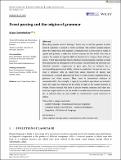Files in this item
Event parsing and the origins of grammar
Item metadata
| dc.contributor.author | Zuberbühler, Klaus | |
| dc.date.accessioned | 2021-12-23T10:30:12Z | |
| dc.date.available | 2021-12-23T10:30:12Z | |
| dc.date.issued | 2021-12-20 | |
| dc.identifier | 277180853 | |
| dc.identifier | b5a4bdb6-7f24-4682-a4ec-5819648833ee | |
| dc.identifier | 85121453901 | |
| dc.identifier | 000731735800001 | |
| dc.identifier.citation | Zuberbühler , K 2021 , ' Event parsing and the origins of grammar ' , WIREs Cognitive Science , vol. Early View , e1587 . https://doi.org/10.1002/wcs.1587 | en |
| dc.identifier.issn | 1939-5078 | |
| dc.identifier.other | RIS: urn:D167F90193235B4FDE6299192071B831 | |
| dc.identifier.other | ORCID: /0000-0001-8378-088X/work/105318160 | |
| dc.identifier.uri | https://hdl.handle.net/10023/24566 | |
| dc.description | Swiss National Science Foundation. Grant Numbers: 310030_185324, 51NF40_180888 | en |
| dc.description.abstract | How did grammar evolve? Perhaps a better way to ask the question is what kind of cognition is needed to enable grammar. The present analysis departs from the observation that linguistic communication is structured in terms of agents and patients, a reflection of how humans see the world. One way to explore the origins of cognitive skills in humans is to compare them with primates. A first approach has been to teach great apes linguistic systems to study their production in subsequent conversations. This literature has revealed considerable semantic competences in great apes, but no evidence for a corresponding grammatical ability, at least in production. No ape has ever created a sentence with an underlying causal structure of agency and patienthood. A second approach has been to study natural communication in primates and other animals. Here, there is intermittent evidence of compositionality, for example, a capacity to perform operations on semantic units, but again no evidence for an ability to refer to the causal structure of events. Future research will have to decide whether primates and other animals are simply unable to see the world as casually structured the way humans do, or whether they are just unable to communicate causal structures to others. This article is categorized under: Cognitive Biology > Evolutionary Roots of Cognition Computer Science and Robotics > Artificial Intelligence Linguistics > Evolution of Language | |
| dc.format.extent | 2640525 | |
| dc.language.iso | eng | |
| dc.relation.ispartof | WIREs Cognitive Science | en |
| dc.subject | Animal cognition | en |
| dc.subject | Meaning | en |
| dc.subject | Primate communication | en |
| dc.subject | Syntax | en |
| dc.subject | Thematic roles | en |
| dc.subject | BF Psychology | en |
| dc.subject | T-DAS | en |
| dc.subject.lcc | BF | en |
| dc.title | Event parsing and the origins of grammar | en |
| dc.type | Journal article | en |
| dc.contributor.institution | University of St Andrews. School of Psychology and Neuroscience | en |
| dc.contributor.institution | University of St Andrews. Institute of Behavioural and Neural Sciences | en |
| dc.contributor.institution | University of St Andrews. Centre for Social Learning & Cognitive Evolution | en |
| dc.identifier.doi | 10.1002/wcs.1587 | |
| dc.description.status | Peer reviewed | en |
This item appears in the following Collection(s)
Items in the St Andrews Research Repository are protected by copyright, with all rights reserved, unless otherwise indicated.

